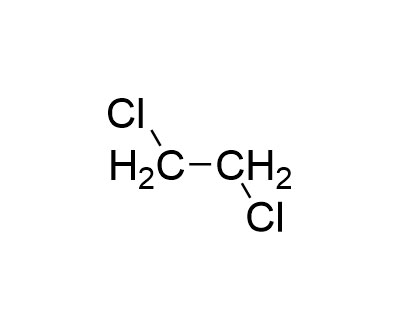

1,2-Dichloroethane, also known as o-dichloroethane, with the chemical formula C2H4Cl2, is a type of halogenated hydrocarbon mainly used as an intermediate in the production of vinyl chloride (polyvinyl chloride monomer) and as a solvent. It is a colorless liquid with a chloroform like odor at room temperature, toxic, and potentially carcinogenic. Possible solvent alternatives include 1,3-dioxane and toluene. Dichloroethane has another isomer: 1,1-dichloroethane, also known as "dichloroethane".
| Chinese name | 1,2-二氯乙烷 | English name | 1,2-Dichloroethane |
|---|---|---|---|
| Chinese alias | 二氯乙烷;对称二氯乙烷;α,β-二氯乙烷;邻二氯乙烷;氟利昂150; 查看更多中文别名 | English alias | Glycol dichloride;Ethane, 1,2-dichloro-;1,2-Dichloroethan;Ethylene Chloride;1,2-ETHYLENE DICHLORIDE; 查看更多英文别名 |
| CAS | 107-06-2 | Molecular formula | C2H4Cl2 |
| Molecular weight | 98.95920 | Accurate mass | 97.96900 |
| PSA | 0.00000 | LOGP | 1.46400 |
| RTECS | KI0525000 |
|---|---|
| BRN | 605264 |
| MDL | MFCD00000963 |
| EINECS | 203-458-1 |
Appearance and characteristics:
Transparent liquid with a smell similar to chloroform
Density:
1.256 g/mL at 25 °C(lit.)
Boiling point:
83 °C(lit.)
Melting point:
-35 °C
Flash point:
60 °F (15.56 °C)
Refractive index:
n20/D 1.444(lit.)
Water solubility:
8.7 g/L (20 ºC)
Storage conditions:
The warehouse is ventilated, low-temperature and dry, and stored separately from oxidants and acids
Steam density:
3.4 (20 °C, vs air)
Steam pressure:
87 mm Hg ( 25 °C)
RTECS:
KI0525000
Safety instructions:
S53-S45-S24-S16-S7
Hazard category code:
R11; R22; R36/37/38; R45
WGK Germany:
three
Customs code:
two billion nine hundred and three million one hundred and fifty thousand
Dangerous goods transportation code:
UN 1184 3/PG 2
Hazard category:
three
Packaging grade:
II
Dangerous goods signs:
F; T
Hazard prevention instructions:
P201; P210; P280; P308 + P313; P370 + P378; P403 + P235
Hazard description:
H225; H302; H315; H319; H331; H335; H350
Danger signs:
GHS02, GHS06, GHS08
Signal words:
Danger
1. The direct synthesis method of ethylene and chlorine gas involves chlorination of ethylene and chlorine gas in 1,2-dichloroethane medium to produce crude dichloroethane and a small amount of multi chloride. Acidic substances and some high boiling substances are removed by alkali flash evaporation, washed with water until neutral, azeotropic dehydration, and distillation to obtain the finished product.
2. Ethylene oxychlorination method: Ethylene is directly chlorinated with chlorine gas to produce dichloroethane. The hydrogen chloride recovered from the cracking of dichloroethane to produce vinyl chloride and the oxygen-containing gas (air) and ethylene preheated to 150-200 ℃ are passed through a copper chloride catalyst loaded on alumina at a pressure of 0.0683-0.1033MPa; Reacting at a temperature of 200-250 ℃, the crude product is cooled to condense most of the trichloroacetaldehyde and some of the water; Pressurization; Refine to obtain dichloroethane product.
3. The method of directly chlorinating ethylene from petroleum cracking gas or coke oven. In addition, in chloroethanol; 1,2-dichloroethane is also produced as a byproduct in the production of ethylene oxide.
4. The industrial product 1,2-dichloroethane is washed with concentrated sulfuric acid until the acid layer is colorless, then washed with a 5% calcium hydroxide solution, and finally washed once with water to separate the water layer. After drying with anhydrous calcium chloride, perform distillation. 1,2-Dichloroethane can form an azeotropic mixture with water, containing 8.9% water and a boiling point of 7.7 ℃. By utilizing this characteristic, a large amount of water is removed and then dried and distilled to obtain pure 1,2-dichloroethane.
5. Suspend catalysts such as ferric chloride, copper chloride, or antimony chloride in dichloroethane as the reaction medium, and introduce gas ethylene and chlorine respectively for reaction. Control the reaction temperature at 50-70 ℃ and the reaction pressure at 0.4-0
5 MPa: The product obtained from the reaction is washed with water to remove hydrogen chloride and catalyst, allowed to settle and separate into layers, and then washed with 1% to 2% sodium hydroxide to separate the water layer. After separating the water layer, azeotropic distillation is performed, and the evaporated azeotrope is allowed to settle and separate the water layer. After drying, it is further distilled to obtain pure 1,2-dichloroethane.
1. Mainly used as vinyl chloride; glycol; Oxalic acid; Ethylenediamine; Tetraethyl lead; Raw materials for polyethylene polyamines and benzoyl. Also used as oil; Resin; Solvent for rubber, dry cleaning agent, pesticide, and pyrethroid; caffeine; vitamin; Hormone extractants, wetting agents, impregnating agents, petroleum dewaxing agents, shock absorbers, and are also used in pesticide manufacturing and the drug imidacloprid; The raw material of piperidine. Can be used as food in agriculture; Fumigant for grains; Soil disinfectants, etc.
2. Used for boron analysis, as an extractant for oils and tobacco. Also used in the production of acetyl cellulose.
3. Used as an analytical reagent, such as a solvent and chromatographic standard substance. It is also used for oil extraction and organic synthesis.
4. Used as a detergent, extractant, pesticide, and metal degreaser.
5. Used as a solvent for wax, fat, rubber, and as a cereal insecticide.